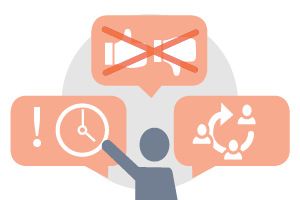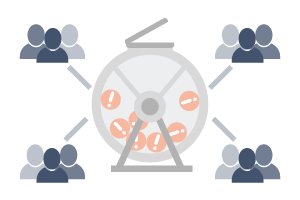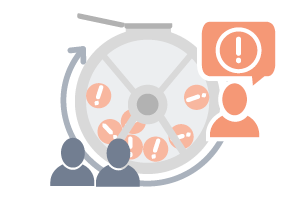
The primary purpose of Pick-a-problem is to allow participants to practice responding to a range of problem scenarios that they are likely to experience in their own context. It helps them to practice in-the-moment, problem-solving skills. Participants are further afforded the chance to listen to others‘ proposed solutions and provide constructive feedback, which can help them generate new ideas on how to address such problems.
OVERVIEW
Pick-a-problem involves small groups of participants (or pairs – see: ‘Practical Tips‘) reviewing and responding to pre-written problem scenarios. Each individual has at least 1 turn to select a random problem from a collection of pre-written scenarios. Each person must immediately respond – as they would be expected to do in a real-life situation. They describe the actions they would take, and why, and then listen to additional suggestions from another group member. Feedback from their fellow participant is provided in a structured way (following the ‘YES…AND…‘ framework). This activity encourages collaboration, creativity, and critical thinking among participants, ultimately leading to more meaningful and actionable solutions.
WORKSHOP PHASE
NUMBER OF PARTICIPANTS
5+
There is no strict minimum number of people required for a Pick-a-problem session, as participants can be divided into groups and work through the problems simultaneously.
TIME |
MODE OF DELIVERY
Minimum 20 minutes | F2F & Online
Note: The exercise can take longer, depending on the number of problems the facilitator would like each group to discuss.
TOOLS/MATERIALS
A container (e.g. a hat or a bag) carrying various problem scenarios.
(Online version: An online spinner wheel or similar tool can be used to randomly select scenarios).
PREPARATION
- The facilitator has to generate a number of problem scenarios. These should be fictional, but also relevant to the participants’ shared context, as well as the workshop objectives. For example “Imagine you are in the following situation: [very briefly describe situation]. A problem arises [describe a specific problem, related to a typical project/context/task/people the participant might encounter]. How do you respond?” Problems should be briefly described, yet specific enough to immediately understand, and should ideally not have an obvious (or even single) correct answer.
- The facilitator decides how many participants will be in each group, and matches the number of problems to at least the number of people in each group.
- A printed copy of each problem scenario is put in a container, e.g. hat/bag. A container is prepared for each group. Online version: An online spinner wheel – or similar online tool - is set up, and the associated hyperlink is copied so that the facilitator can share it with the online breakout room groups.
- The facilitator needs to check that sufficient space is available for the group sessions. Online version: The facilitator should be comfortable using a videoconferencing tool that allows them to set up and manage breakout rooms.

Step 1
The exercise starts with the workshop facilitator briefly introducing the Pick-a-problem format to participants. They should also highlight the following:
a. Once the participant picks the problem, they should describe their response in no more than, e.g., 2 minutes.
b. There is no ‘right’ or ‘wrong’ answer. The purpose is for the participants to practice responding to complex (but likely) issues that could arise in their context. In a real-world situation, they will need to ‘think on their feet’, and this exercise helps them practice that skill.
c. After that, the person immediately to their right should add to the response they just heard. They need to start with 1.) “YES, I agree with….” (mentioning what they liked about the proposed solution) and 2.) “AND, you could consider….”(adding what they would do differently/additionally – if they do have such a suggestion). This feedback should also be brief, and take no longer than 1-2 minutes. After that, the next person draws a problem from the container – moving clockwise in the group.

Step 2
The facilitator then hands out the containers with problems – 1 per group. Online version: Breakout rooms can be set up, using a videoconferencing tool such as Zoom or Teams, for each session. A link to the online spinner wheel/alternative tool is posted in each group’s chat so that they can use this as their ‘container of problems’.

Step 3
The activity starts. The facilitator can move between groups and observe (or even participate in) the activity.

Step 4
Once each participant has had the opportunity to respond to (and to give feedback on the response to) at least 1 problem, the entire group of participants gathers to provide feedback.
Step 5
The facilitator leads a brief group reflection session. They can revisit each problem, and ask the collective group for the best ideas on how to respond to the individual scenarios. Alternatively, they can ask for general feedback – e.g., which scenarios each group felt they had the most difficulty addressing, or which ones generated the most innovative and interesting solutions. Online version: At the end, everyone navigates back to the main, online meeting space, i.e., where the full workshop participant group started. Participants share their reflective feedback via audio or by posting in the chat.
- The success of this exercise relies on the quality and relevance of the problems. The facilitator should focus on writing scenarios that are possible to address, but just challenging enough not to have an ‘easy answer’. It should also be relevant to all the participants so that they can draw on their own knowledge and experience to imagine the situation.
- A variety of types of problems, relevant to the workshop outcomes, should be created.
- The facilitator can test their draft problem scenarios with a co-facilitator or colleague before the session, to check that the descriptions are clear and relevant.
- An AI tool such as ChatGPT can help them to (re-)write the scenarios in a clear and accessible way, without using jargon or terms that could exclude any participants who do not have prior knowledge of such terminologies.
This exercise summary draws from the practical experience of the database contributors.
- Participants can be requested to submit their own problem scenarios, prior to the session, for the facilitator to use. These may need some re-writing, to ensure each ‘problem‘ is clear and relevant to all participants.
- Instead of groups, participants can also work in pairs. This may allow more time for each participant to respond to (and give feedback to their counterpart) each scenario.
« Methods

